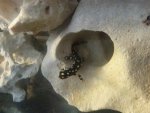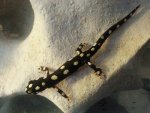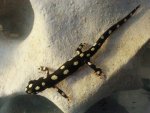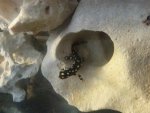I was reading the article on this species on Caudata Culture (which looks to have been written 10 years ago) and I came across this text.
"During the development to adulthood, there are often major problems at a certain point in development. Shortly before reaching sexual maturity, the subadults suddenly become very weak, get sick, and usually 100% of them die in a few weeks. The cause for this is unclear. It is possible that in this phase, a hormonal change in the total physiology of the animals is accompanied by a temporary immune weakness. The Aeromonas infections that have been diagnosed in these cases were caused by germs that ordinarily wouldn’t harm the animals. Macroscopic symptoms on the dead animals, if visible at all, are slightly bloodshot spots on the undersides of the feet. The animals will usually be found dead in the setup without any externally-recognizable cause. It is usually too late to initiate treatment for the remaining animals. The infections have not been known to spread to other salamanders.
In this way, the author has twice lost his complete batch of offspring of N. crocatus (8 and/or 14 animals). On a third occasion, the animals were isolated from one another at the first signs of this illness and kept for several weeks on paper towels soaked with a wide spectrum antibiotic solution, changed every three days. For 4 of the 6 animals, the aid came too late, but 2 survived under these conditions, showing no further symptoms and reaching adulthood without problems.
Because this phenomenon happened in a similar manner to a number of keepers under somewhat different conditions, this seems to be a specific characteristic of N. crocatus. Up to now, most captive bred offspring have fallen victim. In the future, special attention will be dedicated to this problem!
The studbook of Neurergus crocatus currently contains less than 30 animals, which live in various small groups with several European keepers. There were no more breedings or offspring in 2001 or 2002. Therefore, it will take the good will of all keepers of this species to bring together enough animals for viable breeding units and, in a joint effort, prevent this species from becoming extinct in captivity."
Is the development to adulthood still so unlikely? I find it amazing how this species is still in existence if this applies to them all. None of the other genus members has any similar issues to my recollection.
Any information on raising of juveniles to adults would be greatly appreciated.
"During the development to adulthood, there are often major problems at a certain point in development. Shortly before reaching sexual maturity, the subadults suddenly become very weak, get sick, and usually 100% of them die in a few weeks. The cause for this is unclear. It is possible that in this phase, a hormonal change in the total physiology of the animals is accompanied by a temporary immune weakness. The Aeromonas infections that have been diagnosed in these cases were caused by germs that ordinarily wouldn’t harm the animals. Macroscopic symptoms on the dead animals, if visible at all, are slightly bloodshot spots on the undersides of the feet. The animals will usually be found dead in the setup without any externally-recognizable cause. It is usually too late to initiate treatment for the remaining animals. The infections have not been known to spread to other salamanders.
In this way, the author has twice lost his complete batch of offspring of N. crocatus (8 and/or 14 animals). On a third occasion, the animals were isolated from one another at the first signs of this illness and kept for several weeks on paper towels soaked with a wide spectrum antibiotic solution, changed every three days. For 4 of the 6 animals, the aid came too late, but 2 survived under these conditions, showing no further symptoms and reaching adulthood without problems.
Because this phenomenon happened in a similar manner to a number of keepers under somewhat different conditions, this seems to be a specific characteristic of N. crocatus. Up to now, most captive bred offspring have fallen victim. In the future, special attention will be dedicated to this problem!
The studbook of Neurergus crocatus currently contains less than 30 animals, which live in various small groups with several European keepers. There were no more breedings or offspring in 2001 or 2002. Therefore, it will take the good will of all keepers of this species to bring together enough animals for viable breeding units and, in a joint effort, prevent this species from becoming extinct in captivity."
Is the development to adulthood still so unlikely? I find it amazing how this species is still in existence if this applies to them all. None of the other genus members has any similar issues to my recollection.
Any information on raising of juveniles to adults would be greatly appreciated.




